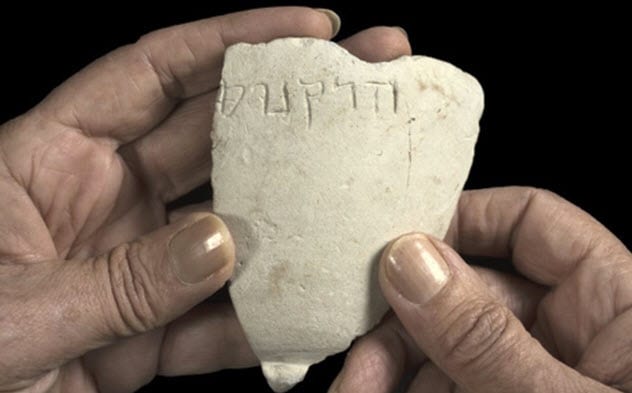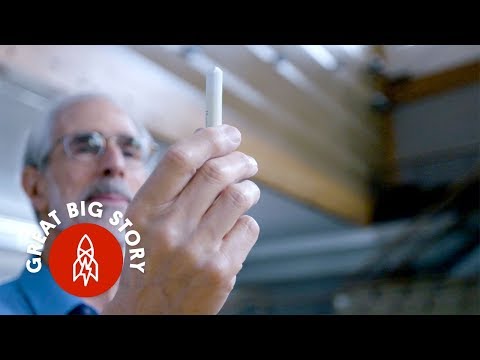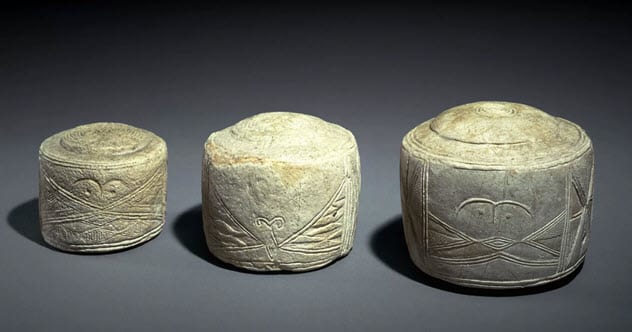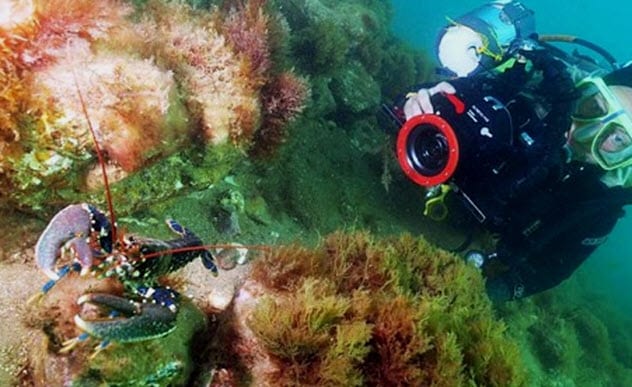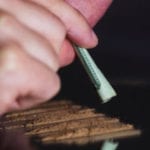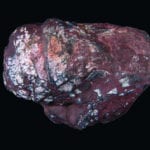From chalk cliffs holding particles from outer space to an unexpected wonderland under the sea, the natural side of this rock hits spectacular highs. Ancient humans also left their mark with mysterious chalk artifacts. Today, criminals and cops alike love their chalk pencils and not in a way that people appreciate.
10 Bat Migration Discoveries
Researchers know plenty about bird migration. However, the science is a bit lacking about arduous journeys made by mammals, including bats. An important first step is to find out which direction the animal takes flight. With birds, researchers usually confine them to an enclosed, small box before release. However, bats just keel over and sleep in such spaces. In 2017, a German scientist took a simple round box. He covered the top with a lid but left enough space for the bat to crawl up the side and escape. The bottom of the circular device was sprinkled with chalk. The bat crawled through the powder, leaving a trail that showed the direction it chose. After 54 bats crawled out of the funnel, it revealed that adults kept flying in the direction they picked upon takeoff. Other tests proved that the sunset helped them to navigate. When confused by reflections of real sunsets, they took off after the pseudo dusk. Juveniles appeared clueless and set off in random directions. This suggested that young bats must learn how to navigate from more experienced elders.[1]
9 Mysterious Bowl Fragment
In 2015, a discovery happened in Jerusalem. For the most part, it was not mysterious. The artifact was a fragment of a chalk bowl made 2,100 years ago. But for experts obsessed with names and neat answers, the shard caused confusion that would last a long time. The chalk bore the name “Hyrcanus.” The Greek name was carved in Hebrew letters, an echo of the Jewish preference for the name during this time. Indeed, two different kings from the Jewish Hasmonean dynasty (140 BC to 37 BC) were called Hyrcanus. Therein lies the scholarly head-scratching. Did the bowl belong to a commoner or a king? There seems to be no right answer. The location of the shard was no help at all but nevertheless interesting. It was found under the Givati parking lot in Jerusalem’s most ancient neighborhood. This is fitting as the fragment is among the oldest examples of its kind found inside the city.[2] Later, chalk vessels became widely used. But so few date from the fragment’s time that researchers cannot say whether the name-inscribed object was commonplace or commissioned.
8 The Fulltouch Panic
In Japan, the Hagoromo Stationery company produced blackboard chalk called Fulltouch. As in, past tense. This sent a flurry of anxiety through academics who could not imagine writing with any other brand. Watch this video on YouTube Most people have written with chalk and experienced the annoying sudden breaks and sticks that refuse to write while causing more dust than a sandstorm. Fulltouch crayons shed no dust. Despite being hard enough to never snap, the chalk wrote like a dream—smooth, bright, and easy to see even by students in the back row. Best of all, the sticks were long-lasting.[3] In 2015, the news of the factory’s shutdown caused some scholars to stockpile enough boxes to last them 15 years. Others delivered tributes online as if they had just lost a close friend. The panic was a bit premature. Hagoromo sold the Fulltouch recipe to a Korean company, and the finest chalk in the world is available once more.
7 Fossil Dust
In 2017, chalk gave scientists the chance to learn more about the solar system’s history. It began with the chalk cliffs in Dover, England, which contain tiny fossilized creatures. Studying the critters has already revealed a lot about Earth’s turbulent geological past. During one such study, researchers unexpectedly discovered that the cliffs also contained fossilized cosmic dust. The dust (aka micrometeorites) was highly sought-after but nearly impossible to find even though 22,000 to 33,000 tons flutters down from space to Earth every year. The problem? The particles are microscopic, and fossilization changes their known minerals to the point of obscurity. But the 76 particles found in Dover were exceptionally well-preserved. Their good looks provided the new criteria by which to find micrometeorites.[4] Similar to animal fossils, the composition of micrometeorites could reveal more about space events in the past. For example, the 87-million-year-old dust could have been formed by asteroids colliding with each other or the planets.
6 Illegal Cop Doodles
In 2019, Alison Taylor got another parking ticket. This time, she did not take it lying down. What angered the Michigan resident was not just the $15 fine but that police had doodled on her car’s tires—again. The parking area in Saginaw had a two-hour limit, and cops used chalk marks to track the time. Taylor’s lawsuit went to federal court. The court system was not kind to the police department. The judge agreed that the practice was unconstitutional because the marks already tagged a driver for an offense not yet committed. Even those who left the parking lot before the two-hour limit drove off with chalked wheels. The case went to the appeals court where a three-judge panel proved even more critical. They deemed that tire marking existed to primarily raise money and not to keep people safe. Indeed, Saginaw raked in almost $200,000 every year thanks to chalk-wielding police officers. The court’s ruling against this “fund-raiser” covered Michigan, Kentucky, Ohio, and Tennessee.[5]
5 Oxfordshire’s Burial Pits
Human history is densely concentrated on the British Isles. To protect this ancient heritage, all construction projects must be preceded by an archaeological investigation to clear the land. In 2019, Thames Water planned to install a pipeline in Oxfordshire. It was part of a conservation project to save Letcombe Brook, a rare chalk stream. While the chalk did not have much to do with the story in this case, its preservation led to something remarkable. Thames Water followed the law and performed an archaeological survey when they found 26 human skeletons. The nature of the burial pits suggested that the funerals—or deaths—happened in a ritualistic manner that likely included sacrifice. The 3,000-year-old group had their body parts moved around. Heads were found near feet, and some had amputated feet flanking the torso. As excavations continued, the team found animal remains, signs of homes, and several domestic items.[6] The artifacts could reveal unknown information about the Iron Age Britons of the time. Not a lot is known about them. But seeing that they created the monumental Uffington White Horse, their culture is worth studying.
4 The Folkton Drums
Over 4,000 years ago in Britain, somebody carved three objects. Made of chalk, they resembled drums with decorations. The set was buried with a child and rediscovered in 1889 near Folkton in Yorkshire. These were no ordinary grave goods. Despite the different sizes—ranging between 10.4 centimeters (4.09 in) and 14.6 centimeters (5.75 in) across—the cylinders had one thing in common. When researchers wound a string around each, a certain measurement arose at one point: 10 “long feet.” Today, a long foot would equal 32.2 centimeters (12.7 in). Back in the day, 10 was the standard used to build henge monuments. The most famous was Stonehenge. The unique artifacts were joined by another chalk drum a century later. Found near England’s south coast, the so-called Lavant drum was also hand-sized and provided 10 long feet when a string was wrapped around it nine times. (The others had to be wrapped 7–10 times.) Nobody knows why the different sizes were necessary when the cylinders all did the same thing. However, as chalk is not the smartest material choice for builders’ tools, the artifacts were certainly replicas of the real thing. The originals were probably wooden.[7]
3 The Longest Chalk Reef
In 2010, divers sought funding from the Norfolk County Council. The group of friends knew there was a chalk area off the coast, although they suspected that it was small. Even so, this suspicion included the presence of a chalk reef they estimated to be around 8 kilometers (5 mi) long. This was a baby compared to the Thanet Coast chalk reefs found in Kent, which were the longest in the world at 22.5 kilometers (14 mi). The county council never regretted doling out the funding for the Norfolk expedition because the divers’ discovery dwarfed the Thanet reefs. The unexpected wonder ran for 32 kilometers (20 mi). The stretch of bright white stunned researchers with its complex arches, many as high as a person and appearing in rows in some places. It had gullies and moonscapes but also an abundance of life.[8] The 300-million-year-old reef had plants, wildlife, and fish, including several species never recorded in the region. Among them was a type of sponge seen for the first time.
2 Chalky Sea Swirls
There are swirls so huge that they cover 16 percent of Earth’s seas and can be seen from space. Called the Great Calcite Belt, its size is only transcended by its ethereal beauty. The swirls shimmer with a milky turquoise iridescence. Found in the Southern Ocean, the giant phenomenon is ironically the result of microscopic organisms. Phytoplankton called coccolithophores are truly small. Each is a single-celled creature that is neither bacterium nor plant. But once in a while, their numbers bloom to epic proportions. The milky hue of the bloom’s swirls is caused by chalk. To protect themselves as they grow, coccolithophores plate themselves with layers of chalk. When they crowd together, the vast number of chalky bodies reflect light into the sky and create the spectacular hues.[9]
1 Gang Chalk Symbols
Around 65 dogs are stolen every day in the United Kingdom. In recent times, these sophisticated gangs appeared to have adopted an open symbolic language to communicate with each other—at the scene of the future crime.[10] Drawn in chalk, the marks appear on pavements, walls, or roads close to the dogs’ homes. Thieves abduct popular breeds as well as trained working dogs. However, it is feared that a large number are stolen for dog fighting—either to fight themselves or to be killed by larger dogs as bait. The symbols most recently appeared in County Durham and Darlington where there was a spate of pet disappearances. Another line of symbols, known as the Da Pinchi Code, appears to mark human victims. They are mostly made of circles, rectangles, lines, and crosses. While their exact meanings remain unknown, some are believed to mark security systems, vulnerable women, wealthy homes, and risky targets. Read More: Facebook Smashwords HubPages

